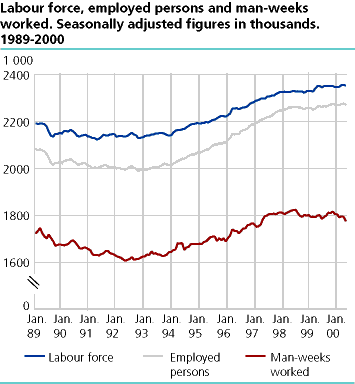Content
Published:
This is an archived release.
More women in full-time jobs
The proportion of employed women working full-time is still increasing. In the fourth quarter 2000 57 per cent of them had full-time jobs, compared to 55 per cent a year before.
In total employment and unemployment only small changes occurred between the fourth quarter 1999 and 2000 according to the Labour Force Surveys (LFS).
Among the employed women the proportion of full-time workers has been increasing since the early 1980s. Among men about 90 per cent are full-time employed. Part-time work is rare among men, and most men with such jobs are pupils or students. In total the number of full-time workers increased by 24 000 from the fourth quarter 1999 to the same quarter 2000, while the number of part-time workers diminished by 22 000.
Lower rate of economic activity among teenagers
About 73 per cent of the population (16-74 years) were either employed or unemployed in the fourth quarter 2000, almost the same as a year before. In the age group 16-19 the rate of economic activity declined. Among persons aged 55-66, however, the activity increased.
Compared with the fourth quarter 1999, there was still a considerable increase in employment within retail trade as well as business services. Manufacturing and agriculture, on the other hand, showed a decline in employment.
Stable unemployment rate
A total of 71 000 persons were unemployed in the fourth quarter 2000, accounting for 3.1 per cent of the workforce, compared to 3.2 per cent the same quarter 1999. Unemployment has been a little reduced among men, but has remained unchanged among women.
The rate of long-term unemployment increased from 17 to 19 per cent last year. Long-term unemployed are those who have been continuously unemployed for more than a half year at the time of the survey.
There were 66 000 underemployed in the fourth quarter 2000, i.e. part-time employed seeking more work. As a percentage of part-time employed, this corresponds to 11.4 per cent, almost the same as in the fourth quarter the previous year.
Continued decline in unemployment in EU and OECD
While the seasonally adjusted unemployment rate in Norway rose from 3.4 to 3.5 from August to November 2000, it fell by 0.2 percentage point on an average in the EU, and by 0.1 percentage point in the OECD-countries. In November the unemployment rate was 8.1 in EU and 6.4 in OECD. The unemployment rate was 4.0 in USA, 5.0 in Denmark (October) and 5.6 in Sweden.
Fewer temporary employed
There were 178 000 temporary employed in the fourth quarter 2000, 14 000 less than the same quarter the year before. The rate of temporary employment was highest in hotels and restaurants, health and social work and in education. Health and social work represented the greatest decline.
Uncertain seasonally adjusted figures
Quality tests show that the seasonally adjusted LFS unemployment figures are uncertain. The seasonal-adjustment method has problems in identifying a seasonal pattern for this series of figures. The random results are relatively large compared to the seasonal component, hence one must keep in mind that the unemployment figures contain a particularly high degree of uncertainty. Statistics Norway plans to publish seasonally adjusted LFS figures based on the observed seasonal pattern after the readjustment in 1996.
Contact
-
Arbeidsmarked og lønn
E-mail: arbeidsmarked@ssb.no
-
Erik Herstad Horgen
E-mail: erik.horgen@ssb.no
tel.: (+47) 93 08 68 62
-
Håvard Hungnes Lien
E-mail: havard.lien@ssb.no
tel.: (+47) 40 90 26 06


